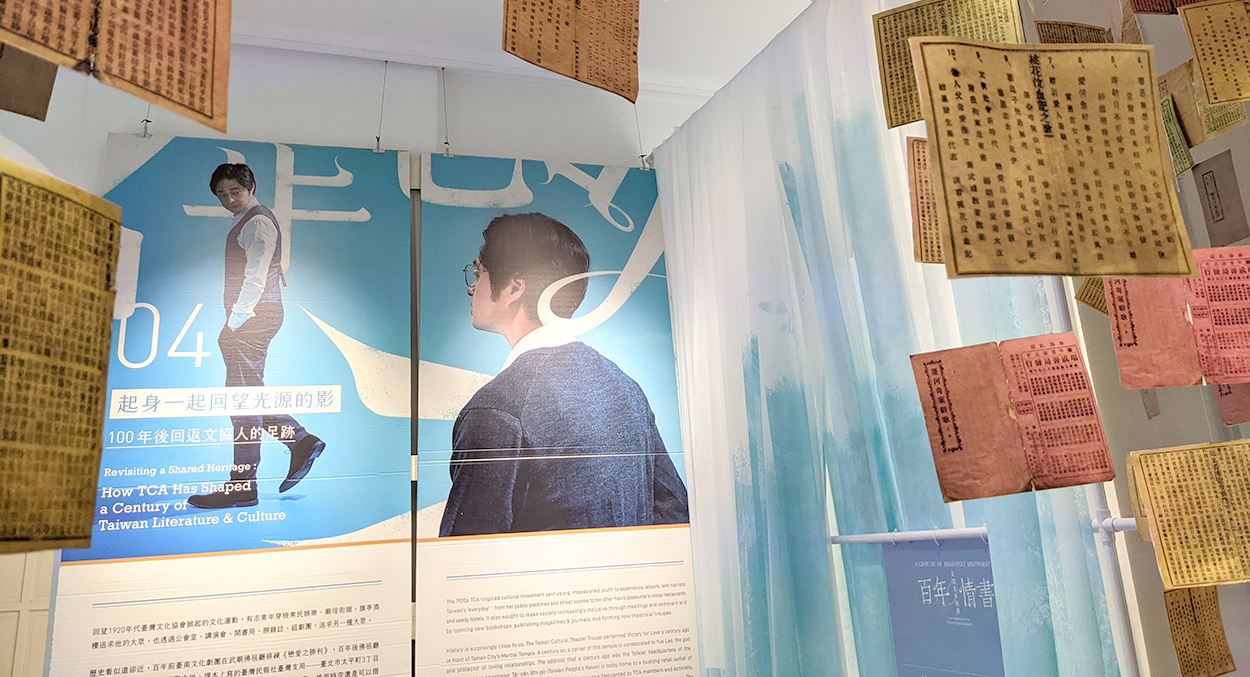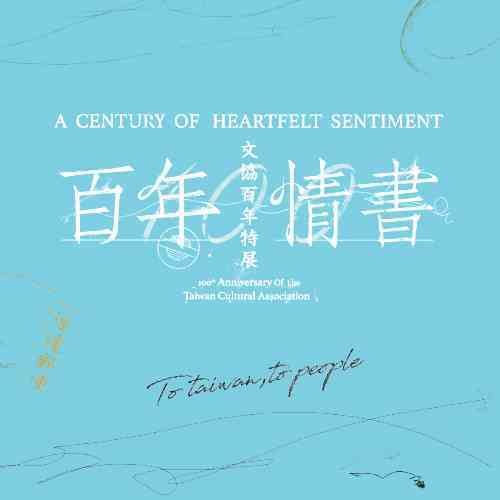
The 1920s TCA-inspired cultural movement sent young, impassioned youth to experience, absorb, and narrate Taiwan's 'everyday' - from her public pastimes and street scenes to her after-hours pleasures in noisy restaurants and seedy hotels. It also sought to make society increasingly inclusive through meetings and seminars and by opening new bookshops, publishing magazines & journals, and forming new theatrical troupes.
History is surprisingly close to us. The Tainan Cultural Theater Troupe performed VICTORY FOR LOVE a century ago in front of Tainan City's Martial Temple. A century on, a corner of this temple is consecrated to Yue Lao, the god and protector of loving relationships. The address that a century ago was the Taiwan headquarters of the groundbreaking newspaper Tâi-oân Bîn-pò (THE TAIWAN MINPAO) is today home to a bustling retail outlet of I-Mei Foods. History can also fold in on itself. Walk in places once frequented by TCA members and activists, you can almost feel yourself brushing against their shoulders and following in their still-visible footsteps. The inimitable spirit and passions of TCA linger on in all of us. Seek out the path of those who came before and overlay their 'love letters' upon our own.
⚑ Cultural Association Map "In the Footsteps of TCA"| Twenty-seven locations related to the Taiwan Cultural Association are shown on this map. Click on each icon to view stories of the association as told through contemporary photos and flyers.👆Click to see the stories related to the Taiwan Cultural Association at each of these locales!

✒ The Cultural Movement Continues. Literary Spirit in Postwar Taiwan
To look for an ideal realm, intellectuals, from the Cultural Association to other cultural figures, volunteered to make contributions in each era. The never-ending history of Taiwan literature started with the Cultural Association. The spirit of the Cultural Association not only examined the past but also focused on the future. The debate over nativist literature in the late 1970s after the war, the formal recognition of Taiwanese literature in the 1980s, the literary diversity in the 1990s, and the cross-disciplinary literary adaptations in the 2020s have all displayed enormous passion to the public. The obstacles that were overcome provide further evidence of the spirit of the Cultural Association.
Here, we mark the cultural movements from the 1920s to the 2020s to remember and record the movements that were and those that continue to this day.
✤ Chronology of the Taiwan Cultural Association ✤
1920s ——
| 1914 | ▸ In December, Lin Hsien-tang and Itagaki Taisuke establish the Taiwan Assimilation Society. |
| 1921 | ▸ The Taiwan Cultural Association is founded on October 17th. The first issue of TAIWAN CULTURAL ASSOCIATION CORRESPONDENCE is published in November. |
| 1922 | ▸ "Horrible Silence" (Chinese), "Chasing The Wind" (Xie Chun-mu), and "Where Is She Going" (Japanese) are published as the earliest works of Taiwan new literature. |
| 1923 | ▸ On October 17th, the headquarters of Taiwan Cultural Association is relocated to Tainan. |
|
1924 |
▸ Zhang Wu-jun releases "A Letter to Young People in Taiwan" and "Terrible Taiwanese Literary Scene" respectively in April and November in THE TAIWAN MINPAO. He first criticizes the old literary scene in Taiwan, triggering a debate on new and old literature. |
| ▸ On July 3rd, under Lin Hsien-tang's leadership, "The Meeting of Powerless Civilians Across Taiwan" is held in Taipei, Taichung, and Tainan as a protest against the "Meeting of The Powerful" held by Koo Hsien-jung. | |
| ▸ On August 10th, Lin Hsien-tang recruits 40 studious young men to open a summer school at the Lin family residence in Wufeng. | |
|
1925 |
▸ In August, Loa Ho publishes the prose work "Untitled" and a modern poem "Sacrifice with Awareness: For My Comrades in Jierlin Incident" in THE TAIWAN MINPAO. |
| ▸ In September, Tsai Pei-huo releases Cha̍p-hāng Kóan-kiàn, which lists the ten most important social lessons for Taiwanese people. | |
| 1926 | ▸ In October, Chen Cheng-po's OUTSIDE CHIAYI STREET is featured in the 7th Empire Art Exhibition. |
|
1927 |
▸ In August, the government-general of Taiwan allows THE TAIWAN MINPAO to relocate to Taiwan. |
| ▸ Huang Jin-huo founds the Tainan Cultural Theatre at Republic Hospital. | |
| 1929 | ▸ In July, the Chihkan Youth Association, formed by young people in Tainan, initiates a movement against the ghost festival. SPECIAL FEATURE ON ANTI-SUPERSTITION is released in September 1930. |
|
1930 |
▸ On March 29th, THE TAIWAN MINPAO is reorganized and Taiwan Xinming Newspaper is founded. TAIWAN HSIN MIN PAO is published daily starting from April 15th, 1932. |
| ▸ In August, Huang Shi-hui's "Why is Nativist Literature Not Being Promoted?" is published in WUREN NEWSPAPER, triggering the lively early-1930s debate on Taiwanese literature. | |
| 1931 | ▸ Zhang Wei-xian returns to Taiwan from Tokyo and founds the Minfeng Theatre Center. |
|
1932 |
▸ In April, Loa Ho, Chen Xugu, Lin Pan-long, and Xie Xing-lou take responsibility for the literature department of TAIWAN HSIN MIN PAO. |
| ▸ In May, Yang Kui's "Paper Delivery Person" is published in installments in TAIWAN HSIN MIN PAO. | |
| 1933 | ▸ "Longing for Spring Breeze" written by Lee Lim-chhiu (lyrics) and Teng Yu-hsien (music) is released. It is performed by Chun Chun. |
|
1934 |
▸ On August 26th, Xu Yu-chun, Zheng Pan-ming, Lin Kuai-qing, and Lin Wen-shu found the Taiwan Literature Alliance, Chiayi Branch. |
| ▸ REFORM, edited by Li Xiang-zhang, is published by the Daxi Reform Society. | |
| 1935 | ▸ In June, Wu Xin-rong, Guo Shui-tan, Wang Deng-shan, Zhuang Pei-chu, and Lin Fang-nian establish the Taiwan Literature Alliance, Jiali Branch. |
| 1936 | ▸ In December, the 10th issue, first volume of TAIWAN NEW LITERATURE carries the "Special Feature on Literary Works in Chinese." However, it is prohibited due to charges of improper content. |
| 1938 | ▸ N̂g Hōng-chu, a third-year primary student at Taipei Longshan Public School, has her work "Yuanzai" published in THE CUSTOMS OF TAIWAN. She later also releases two books, SEVEN STAR GODDESS and SEVENTH AND EIGHTH MASTERS, which earn her the title of "Taiwan's Literary Girl." |
1940s ——
| 1940 | ▸ In January, Yeh Shih-tao's first novel "Mazu Ceremony" is submitted to TAIWAN LITERATURE and receives an honorable mention. |
| 1941 | ▸ On April 9th, Kōmin Hōkōkai is founded. |
| 1942 | ▸ Long Ying-zong is elected as the Taiwanese representative to attend the First Greater East Asia Literary Conference in Tokyo. |
| 1943 | ▸ In April, the Taiwan Writers Association is reorganized into the "Taiwan Literature Hōkōkai" under Kōmin Hōkōkai to promote patriotic (Japanese) sentiment and promote Japanese culture. In May, 1944, TAIWAN LITERARY MAGAZINE is founded. On January 5th, 1945, the magazine is suspended. |
|
1946 |
▸ Wu Chuo-liu's HO CHI MINH (Orphan of Asia) is published. |
| ▸ Long Ying-zong serves as Chief Editor of the Japanese edition of the "Literature Column" in CHINA DAILY NEWS. | |
| 1947 | ▸ February 28th (228) Incident. |
| ▸ August: "Qiao Supplement" of TAIWAN SHIN SHENG DAILY NEWS first published. | |
| 1948 | ▸ The article "How to Establish the New Taiwan Literature" by Yang Kui was published in the March 29th issue of the "Qiao" supplement of TAIWAN SHIN SHENG NEWS. This essay discussing strategies for re-establishing “new” Taiwan literature marked the opening shot in the postwar debate over Taiwan literature. |
| 1949 | ▸ May: Yang Kui is tried by a military court for his "PEACE MANIFESTO." |
| ▸ June: Lin Hsien-tang is appointed Chair of the Taiwan Historical Documents Committee. | |
|
1951 |
▸ January: the OBSERVER magazine is founded. |
| ▸ February: CHINESE LITERATURE is founded. | |
| ▸ September: Yeh Shih-tao is arrested by the State Security Bureau and sent to prison. In July 1953, he is sentenced to 5 years in prison for "not reporting communist activities." Lin Hai-yin serves as Chief Editor of the literary supplement of the United Daily News. Chung Chao-cheng's first article "After Getting Married" is published in FREE TALKS, marking the beginning of his writing career. | |
|
1953 |
▸ January: LITERARY TRAIN is founded. |
| ▸ February: Ji Xian founds the Modern Poetry Society. MODERN POETRY begins publication. | |
| 1954 | ▸ April: Chinese Writers & Artists Association initiates the "Cultural Cleansing Movement" aimed at combating "the poison of communism," "the harm of erotism," and "the sin of criminality." |
|
1965 |
▸ October: Yeh Shih-tao temporarily withdraws from public life after his release from prison. He returns to the literary scene with Chinese writings, including his novel "Youth" published in LITERARY SCENE and his critique - "Taiwan's Nativist Literature." |
| ▸ The ten-volume "A Collection of Works by Taiwanese Writers," edited by Chung Chao-cheng, is published by Literary Scene Publishing House. The ten-volume "Taiwan Youth Literature" is published by Youth Bookstore. | |
| 1976 | ▸ December: Li Shuang-tze advocates "singing our own songs" using our own language after the Tamkang incident. |
| 1977 | ▸ CACTUS was founded in March. Later that year, in April, Wang Tuoh's article "It Is Literary Realism, Not Nativist Literature" in the second issue of the journal triggered a hotly contested debate over nativist literature. |
|
1979 |
▸ March: Li Nan-heng serves as chief editor of the five-volume "New Taiwanese Literature During the Japanese Colonial Period." |
| ▸ July: Yeh Shih-tao and Chung Chao-cheng jointly edit the eight-volume "TAIWANESE LITERATURE BEFORE RETROCESSION." |
1980s ——
| 1987 | ▸ February: Yeh Shih-tao's HISTORY OF TAIWANESE LITERATURE is published by Chun Hui Publishing House as the first book on the history of Taiwanese literature in Taiwan. |
| 2001 | ▸ During the 80th anniversary gala for the Taiwan Cultural Association, ROC President Chen Shui-bian proclaimed October 17th as “Taiwan Cultural Day” to commemorate the spirit of the Taiwan Cultural Association. |
| 2003 | ▸ To commemorate the spirit of the Taiwan Cultural Association, the National Museum of Taiwan Literature (NMTL) officially opened on October 17th. This day is now celebrated each year as NMTL’s anniversary. |
| 2006 | ▸ The Council for Cultural Affairs coordinated the launch by museums in central Taiwan of "History, Action - 2006 Cultural Day / Launch of the Central Taiwan Cultural Circle" on October 17th. |
| 2021 | ▸ On March 11th, the Executive Yuan passed the draft of "The Organization Act of the National Museum of Taiwan Literature" and upgraded the museum to a Class III organization. |










